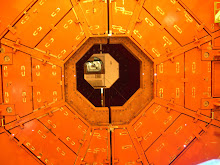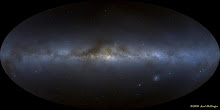 Nature had her own ideas about testing LHC safety. A thunderstorm last Friday knocked out some transformers at the LHC near Geneva that are part of the helium cooling system, that cools the magnets that keep the proton beams travelling (near light speed) on a circular path through the collider. Technicians have been scrambling to fix the problems, but not before some magnets warmed well above standard operating temperatures, some reaching almost 7K from the usual ultra cold 1.9K .
Nature had her own ideas about testing LHC safety. A thunderstorm last Friday knocked out some transformers at the LHC near Geneva that are part of the helium cooling system, that cools the magnets that keep the proton beams travelling (near light speed) on a circular path through the collider. Technicians have been scrambling to fix the problems, but not before some magnets warmed well above standard operating temperatures, some reaching almost 7K from the usual ultra cold 1.9K .Electromagnets at the LHC need to be this cold to be superconducting, or at peak efficiency, in order to deliver extremely high magnetic fields in the 27 km ring of 1200 giant magnets and thousands of smaller ones, at 8.33 Teslas or about 200,000 times the earth's magnetic field strength.
Everything about this atom smasher is boggling, including the numbers, like its cost at about $10 billion and CERN's yearly operating budget of $1 billion, with over 2500 physicists working on site.
Reports from CERN today state that repairs were successful and the collider will be poised for proton collisions next week at a base energy of 0.90 Trillion Electron Volts. CERN is aiming for much higher energies never before attempted, 5 TeV per beam before October 12th.
CERN didn't say whether the collider was operating with beams or not during the emergency. If it had beams shooting through the ring, protons could have scattered, further warming and quenching some warm magnets, that might have exploded if the automatic heaters had also been affected by the power failures. Several sectors did warm partially at the LHC. If they all had, in the worst case scenario, beams might have unravelled and crashed down the LHC, causing a catastrophic failure. With the warming of magnets and helium coolant, up to 40 refrigeration plants above and below ground could have failed, usually with a loss of helium. In December 2003, the Tevatron had a catastrophic beam loss and a major quench, not related to thunderstorms.
Some hassles during storms have hampered operations at Fermilab's Tevatron, currently the most powerful collider until the LHC goes full blast. Even though both colliders are largely underground, lightning travels well though moist earth or wet clay, and part of the LHC in the vicinity of the second largest experiment, the CMS, has been excavated from clay, so unstable that it had to be artificially frozen during excavation of the giant CMS cavern. Hence its nickname at CERN, see-a-mess.
Like any machine the LHC is vulnerable to its environment and its own weaknesses, not forgetting the colossal energies and particle collisions it will produce.
News Stories On LHC Thunderstorm
Henderson, Mark. "'Big Bang Machine' is back on collision course after its glitches are fixed", Sept 18, 2008, TimesOnline,
http://www.timesonline.co.uk/tol/news/uk/science/article4774817.ece
Brouet, Anne-Marie. "Panne de faisceau dans le LHC", Sept 17, 2008, Tribune de Genève, http://www.tdg.ch/geneve/actu/2008/09/16/systeme-froid-gele-faisceau-lhc
Highfield, Roger. "The Large Hadron Collider: First subatomic particle collision to happen next week", Sept 16, 2008, Telegraph UK, http://www.telegraph.co.uk/earth/main.jhtml?view=DETAILS&grid=&xml=/earth/2008/09/16/scilhc116.xml
LHC Costs And Benefits
O'Neill, Martin. "Politics of proton smashing", Sept 17, 2008, New Statesman,
http://www.newstatesman.com/international-politics/2008/09/physics-lhc-cern-scientific
Tevatron Thunderstorms at 100,000 electron volts
Mosher, Dave. "Lightening strikes, Tevatron blinks", Oct/Nov 2006, Symmetry Magazine,
http://www.symmetrymagazine.org/cms/?pid=1000391
Tevatron Quenches and Failures
Gillis, Alan. "Major Failures At The Tevatron", Apr 18, 2008, The Science of Conundrums,
http://bigsciencenews.blogspot.com/2008/04/major-failures-at-tevatron.html
 Cointrin
Cointrin

























No comments:
Post a Comment